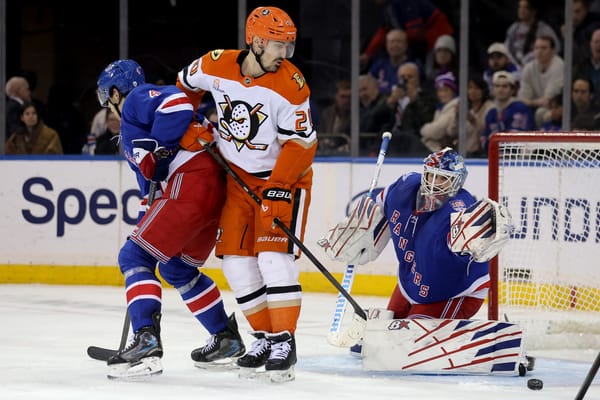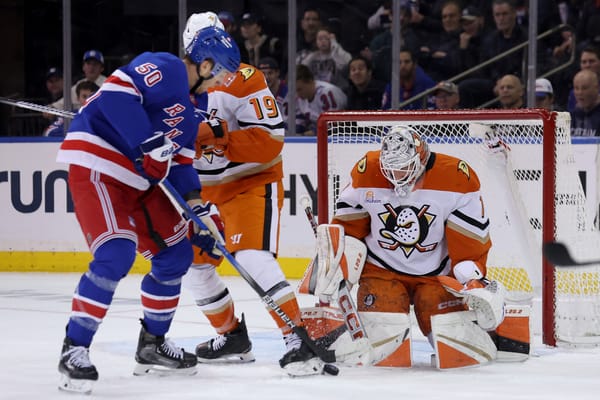Zac Jones Raising His Stock With Early College Season Success
The Rangers’ 2019 third-round pick is following in the footsteps of Adam Fox.
Adam Fox fell all the way to the Calgary Flames at 66th overall in the 2016 Draft despite his obvious talent. The Long Island native was a standout in the USHL during his draft season, but his lack of physical attributes drew the skepticism of amateur scouts. A few years later, Fox has made a vociferous statement early into his NHL career; the scouts had it wrong.
The Rangers are hoping for a similar fate with Zac Jones, whom the team similarly drafted in the third round of the 2019 draft. Granted, their situations are not identical. Jones is fairly old for his draft year, having turned 19 in October. Whereas Fox was a household name on the US National Development team, Jones lurked in the shadows of draft discussion. And with how exceptionally well Fox is playing early in his NHL career, it’s probably unwise to even hint at a possibility that Jones could mimic his success.
Still, their games — and scouts’ reasons for skepticism — are remarkably similar. And though plenty of scouts have knocked Jones for the same reasons they knocked Fox, he does have a cult following of sorts.
“I think New York is going to look like geniuses in a couple of years,” is what Jones’ USHL coach told The Athletic’s Corey Pronman in early October.
While it’s far too early for the Rangers to claim victory, Jones has taken Hockey East by storm in his freshman season with UMass, generating two goals and seven assists through eight games. He’s tied for third among all NCAA defensemen (minimum five games) by points-per-game and is first among all U20 defensemen by quite a bit (via Elite Prospects).
At 5’10 and 176 pounds, Jones is certainly undersized for a defenseman. Typically, the advantage these types of players hold is skating ability, but Jones’ stride is clunky. He lacks explosiveness and his top gear is average at best.
Like Fox, Jones more than compensates for these deficiencies with agile feet and quick processing ability. His poise on the puck is tremendous. He doesn’t panic when under pressure and is nimble enough to escape tight spaces to create plays where one doesn’t ostensibly appear available (#24 in white).
While Jones doesn’t possess a threatening shot, he is adept at getting pucks through the layers of defense. A hard shot always helps, but beating goaltenders in today’s hockey requires more than that. Goalies are too good and defensive structures are too impenetrable to rely on blasting pucks into the net like in decades’ past. Jones will bait forwards into committing to a shot block before pivoting in another direction. He uses screens to his advantage and successfully shoots the puck through tight openings. Most prominently, he has a knack for placing shots in areas ripe for teammate redirections and tip-ins. Jones creates offensive from the point with misdirection.
He also does so with vision. As noted in our Summer Prospect Rankings, Jones thinks multiple steps ahead. He always knows what he wants to do with the puck well before he receives it, which puts him in position to make plays in a flash.
The lack of size and speed ostensibly makes Jones a defensive liability. As with Fox, that is not the case. For one, there’s the general philosophy that a player doesn’t have to defend so long as his/her team has possession. Jones is the kind of player to drive play for his team and ensure they have more offensive zone time than the opponent.
But beyond that, Jones compensates with quick thinking and good footwork. It’s not often that he’s caught on the wrong side of a player. He anticipates where the play is going with such efficiency that he’ll often beat speedier players to loose pucks. His gaps are excellent and he closes down on puck carriers at the right times. Here’s a great example where he extinguishes transition possibilities twice during the same shift.
He is deliberate with his stick positioning and is proficient at cutting off passing lanes.
Jones (like Fox) is a great example of why quickness isn’t just about literal velocity. Jones processes the game at an elite level and has the foot dexterity to really make it count. It was one thing to make these types of plays in the USHL, but that Jones has taken Hockey East by storm makes him a prospect worth reckoning with. He has beaten up on a few mediocre teams, but the flip side is that he’s not really benefitting from much talent around him. UMass is actually a quality hockey school, but it’s one that lacks starpower. In fact, Jones himself may be the closest they have. He’s second on the team in points and has turned into a stalwart on defense. Again, it’s very similar to Fox’s experience at Harvard.
Eight successful games aren’t enough to make an NHL future a surefire destiny, but it certainly Is enough to elevate his stock. The politics of USA Hockey always muddies the waters, but one would think Jones will be in the conversation for the World Junior Championships next month.
The best part for the Rangers is that there’s no rush with Jones. Other defensemen on the roster or soon to join will offer the NHL and AHL coaching staffs enough toys to play with. In the meantime, Jones could marinate in college hockey for multiple years before turning pro. Just as Fox did. Can he add just a touch pace and muscle in the meantime? That may be enough to make him a particularly dangerous player.
Again, it’s unrealistic to expect that Jones will live up to the standard Fox is currently setting. Still, it’s uncanny how similar the two players are both in skillsets as well as paths towards the NHL. With some luck, the Rangers could perhaps see them on the same pairing someday.




